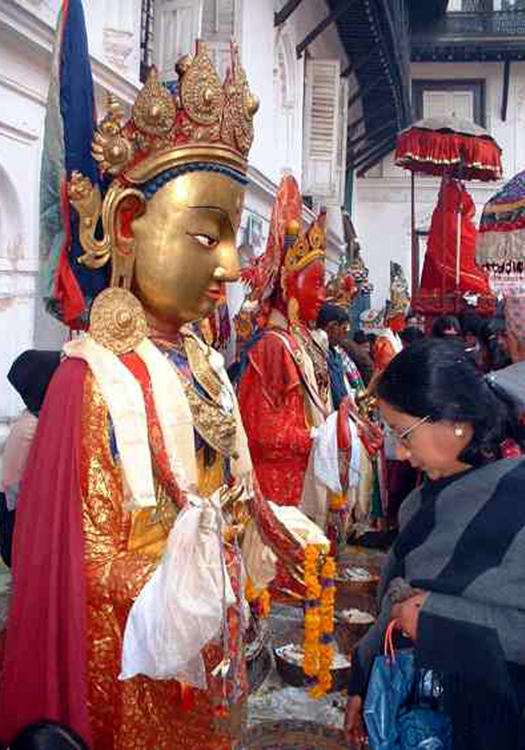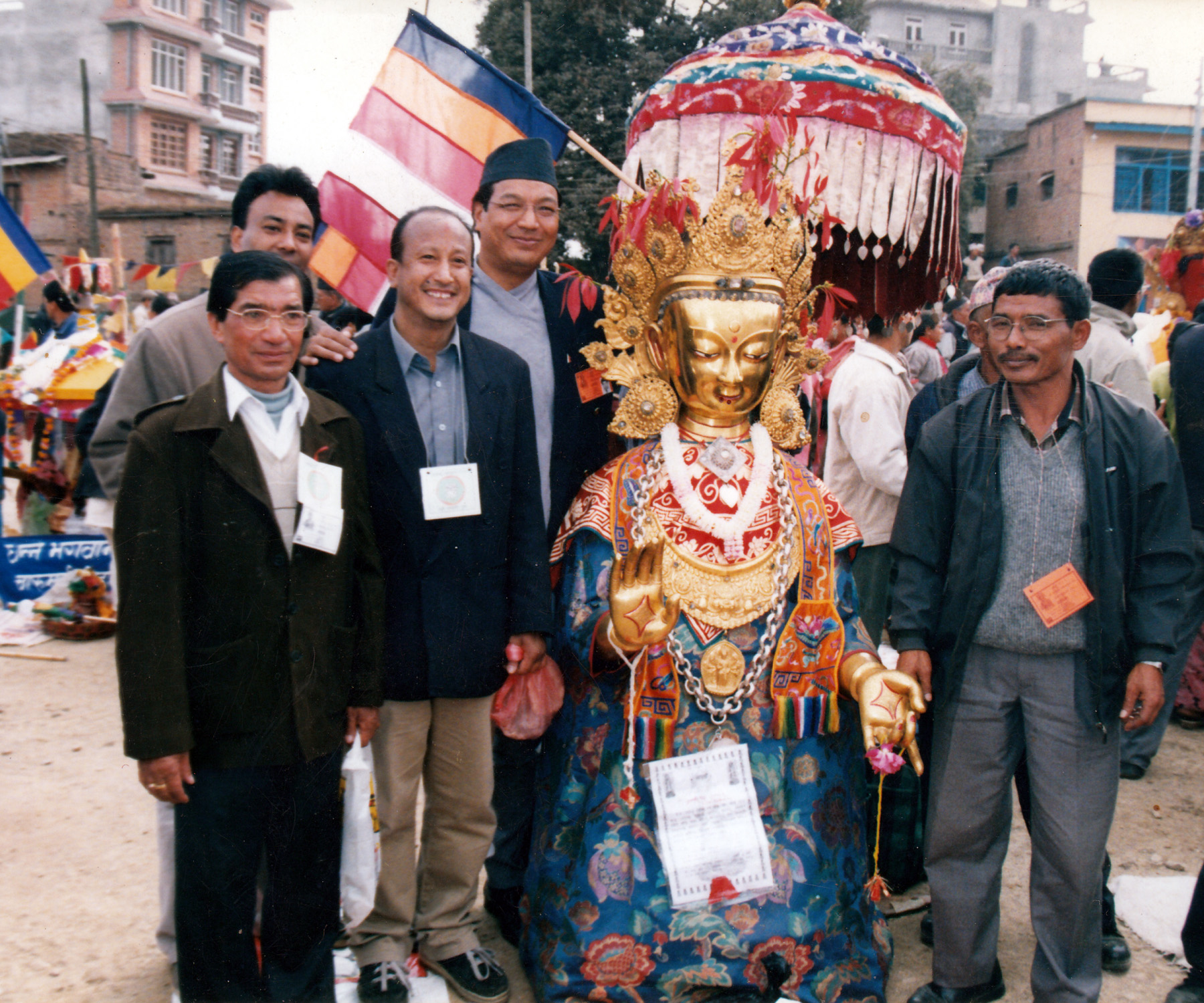Samyak on:
[Wikipedia]
[Google]
[Amazon]

 Samyak ( ne, सम्यक) is an almsgiving Buddhist festival celebrated in the
Samyak ( ne, सम्यक) is an almsgiving Buddhist festival celebrated in the

 Samyak ( ne, सम्यक) is an almsgiving Buddhist festival celebrated in the
Samyak ( ne, सम्यक) is an almsgiving Buddhist festival celebrated in the Kathmandu Valley
The Kathmandu Valley ( ne, काठमाडौं उपत्यका; also known as the Nepal Valley or Nepa Valley ( ne, नेपाः उपत्यका, Nepal Bhasa: 𑐣𑐾𑐥𑐵𑑅 𑐐𑐵𑑅, नेपाः गाः)), ...
in Nepal
Nepal (; ne, नेपाल ), formerly the Federal Democratic Republic of Nepal ( ne,
सङ्घीय लोकतान्त्रिक गणतन्त्र नेपाल ), is a landlocked country in South Asia. It is ma ...
. During the ceremony which is held on a large open ground, hundreds of Dīpankara Buddha images are assembled, and gifts of different types of food are made to the Buddha images and the Buddhist community.
Samyak is the most spectacular Newar Buddhist celebration. It is observed at different intervals in the three cities of the valley -- every 12 years in Kathmandu
, pushpin_map = Nepal Bagmati Province#Nepal#Asia
, coordinates =
, subdivision_type = Country
, subdivision_name =
, subdivision_type1 = Provinces of Nepal, Province
, subdivision_name1 ...
, every five years in Lalitpur and annually in Bhaktapur
, motto = ne, पुर्खले सिर्जेको सम्पत्ती, हाम्रो कला र संस्कृति , lit=Creation of our ancestors, our heritage and culture
, image_map ...
. The first documented Samyak festival in Kathmandu took place in 1015 AD (135 Nepal Era
Nepal Sambat, also spelled as Nepala Sambata, ( Nepal Bhasa: , Nepali: ) is the lunisolar calendar used by the Newari people of Nepal. The Calendar era began on 20 October 879 AD, with 1142 in Nepal Sambat corresponding to the year 2021–2022 ...
).
The festival brings together a wide cross-section of Newar
Newar (; new, नेवार, endonym: Newa; new, नेवा, Pracalit script:) or Nepami, are the historical inhabitants of the Kathmandu Valley and its surrounding areas in Nepal and the creators of its historic heritage and civilisation ...
society, including priests, artisans, traders, musicians and farmers. Each group has a defined role designed to highlight social harmony. The ceremony celebrates the practice of giving to the Buddhas and monks in the Newar Buddhist tradition. The Samyak festival in Kathmandu is held at Kathmandu Durbar Square and the field of Bhuikhel
Bhuikhel ( ne, भुइखेल) is a large plain located in the western part of Kathmandu at the foot of Swayambhu hill. Also known as Bhukhel (भुखेल), it is famed for the Buddhist Samyak festival held here.
The field is one of ...
at the foot of Swayambhu
Swayambhu ( sa, स्वयंभू) is a Sanskrit word that means "self-manifested", "self-existing", or "that is created by its own accord".
Often, the word swayambhu is used to describe a self-manifested image of a deity, which was not made ...
hill.
Day One
On the first day, large images of Dipankar Buddha are brought out of sacred courtyards and private homes and displayed at Durbar Square in a row to receive offerings from devotees.Day Two
On the second day, the statues are carried in procession toBhuikhel
Bhuikhel ( ne, भुइखेल) is a large plain located in the western part of Kathmandu at the foot of Swayambhu hill. Also known as Bhukhel (भुखेल), it is famed for the Buddhist Samyak festival held here.
The field is one of ...
and assembled on the field. Priests receive alms consisting of different kinds of sacred foods in a ceremony held in the presence of the king.
The offerings are made by members of the Uray caste group. Each subgroup performs a task that has been assigned by tradition.
* Tuladhars of Asan
Asan () is a city in South Chungcheong Province, South Korea. It borders the Seoul Capital Area to the north. Asan has a population of approximately 300,000.
Asan is known for its many hot springs and is a city of spas.
Asan has grown into t ...
sew and distribute leaf plates
* Tuladhars of Nyata cook and serve rice
* Sthapits build the wooden viewing stand
* Tamrakar
Tāmrakār (Devanagari: ताम्रकार) is a caste of coppersmiths and other metal casters found in Nepal and India. In Nepal, the Tamrakars are found among the Newar community of the Kathmandu Valley.
Etymology and names
The name Ta ...
s play the trumpet
* Kansakars prepare and serve five types of foods
* Sikhrakars supply clay pots
* Banias serve a sweet drink
* Selaliks serve confections
Misā Samyak
Misā Samyak, which means Women's Samyak, is held on the third day. The image of Goddess Ajimā Dyah is brought down from her shrine at Swayambhu for the ceremony.Timetable
The regular Samyak ceremony is held at intervals of 12 years. However, a special one can be called between the scheduled occurrences by a sponsor. The most recent one took place in 2005. In Lalitpur, the Samyak festival is held at Nagbahal every five years. The latest one occurred in 2020. In Bhaktapur, Samyak is celebrated annually on the feast day of Ghyah Chāku Sanlhu (Maghe Sankranti
Maghe Sankranti (, , Nepal Bhasa: ) is a Nepali festival observed on the first of Magh in the Vikram Sambat (B.S) or Yele calendar bringing an end to the winter solstice containing month of Poush. Tharu people celebrate this particular day as ...
) which usually falls on January 15.
References
{{reflist Newar Buddhist holidays Buddhist festivals in Nepal 11th-century establishments in Nepal